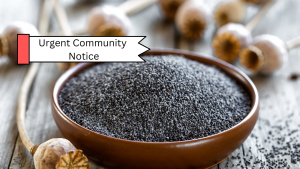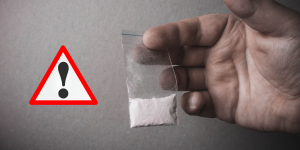
Safer Using – Tiletamine
About Tiletamine Tiletamine is a dissociative anaesthetic used in veterinary medicine to immobilise, sedate or anaesthetise animals for surgery, most…
Heroin (AKA diacetylmorphine or diamorphine) is a depressant drug belonging to the semi-synthetic opioid class.1 It goes by many slang names: smack, gear, junk, horse, slow, H, brown, hammer and Harry.1,2 Heroin is known for its ability to produce intense euphoria, relaxation and pain relief which lasts a few hours.3,4 It can be snorted, smoked, shafted, injected under the skin (subcutaneous), or injected into veins (intravenous or IV).4 If taken by mouth, it is mostly converted into morphine in the liver.4
In 2023, the Australian Capital Territory decriminalised the possession of small amounts of recreational drugs.5 This means you may receive a health intervention or fine instead of conviction if you’re caught with up to 1 gram of heroin.5 For more information, see this helpful graphic.
Heroin is chemically manufactured from morphine, which is naturally produced by the opium poppy (Papaver somniferum).6 This makes heroin a semi-synthetic opioid because it is synthesised from a natural opioid, rather than from scratch. In the body, heroin is converted back into morphine, which is what produces the characteristic euphoria, relaxation, and pain relief.4 However, the small chemical modification means heroin is better able to pass into the brain before it is converted into morphine, causing the effects to be far more intense and short-lived.4

The chemical structure of heroin is almost identical to morphine apart from the two additional acetyl groups (highlighted in green).
Heroin primarily comes in two forms: heroin base and heroin salt (or heroin hydrochloride (e.g. diacetyl-morphine hydrochloride).2,7 The more highly refined white heroin is almost always converted into the heroin salt (hydrochloride), while less refined brown heroin is often (but not always) found as a base. Brown heroin is also often cut with caffeine to bring down the temperature at which it vapourizes, so that it can be smoked before too much heat destroys it.
White heroin is the most common type found in Australia, but brown heroin is more common in the UK and Europe.2,7 Heroin salt readily dissolves in water making it suitable for injecting.2,7 Heroin base is less soluble in water and vapourizes at a lower temperature making it more suitable for smoking.2,7
Base heroin requires the addition of an acid (ideally sterile ascorbic or citric acid or vitamin C) before it can be dissolved in water and injected (see The Safer Injecting Handbook for more info).8 It is often not obvious whether heroin is base or salt when judging on appearance alone because either type can appear brown or white.2 If it is unusually difficult to dissolve in water, then it is most likely base heroin.2
In Australia, the majority of people who use heroin inject it intravenously. The most commonly injected drugs in Australia are heroin and methamphetamine.9 Injecting drugs carries some risks including vein damage, overdose, infection with blood-borne viruses (BBVs), and bacterial infection.8 The spread of BBVs has greatly reduced thanks to the availability of treatments and clean injecting equipment at needle and syringe programs (NSPs).10 However, hygiene, filtering, dosing, and vein care are all very important elements of harm reduction and can sometimes be difficult to get right.8,11
There are many fantastic harm reduction resources for injecting drugs such as AIVL’s Vein Care Guide and The Safer Injecting Handbook. For further information you can contact CAHMA and chat with a non-judgemental health professional about vein care and harm reduction.
The adulteration of drugs—including heroin—with fentanyl and other synthetic opioids have been major drivers of the overdose crisis in the US and Canada. In Australia, the number of deaths caused by synthetic opioids has increased over the last two decades.12 Moreover, potent synthetic opioids in the nitazene class have recently been detected in heroin samples.13 It is more important than ever to carry naloxone (see section on overdose below) and to test your heroin either by using fentanyl test strips (e.g., https://dancesafe.org/fentanyl/) or ideally by taking it to a drug checking service such as CanTEST.
The effects of drugs can vary from person to person, but the effects of heroin commonly include3
The effects of heroin will come on almost instantly when injected intravenously, or up to two minutes when snorted.3,14 The effects generally last for 3-5 hours.3,14
People react differently to drugs due to differences in bodyweight, metabolism, and a range of other factors. It’s also very difficult to determine the potency of drugs sold on the street. Hence, it’s always better to start with a low dose and wait before redosing drugs (start low and go slow).
The correct dose of heroin to produce your desired intensity of effects depends on the way you consume it, as well as your tolerance, and your metabolism.3,14 It should also be noted that street heroin is generally not taken orally because only about a quarter of the substance is effectively metabolised that way, requiring four times as much to be taken for an equivalent dose.
Tolerance to heroin builds quickly and a larger dose may be required to produce the same intensity of effects following repeated use. Tolerance also fades, so if you’ve taken a break from heroin, start with a dose smaller than you would use previously. A break of only a week or two can cause a significant decrease in tolerance, so be careful!
The following dosage guide is for an opioid naïve person (someone with no tolerance) and is only a guide. Everyone is different and some people can overdose on a hit that another person would barely feel. If you are using heroin for the first time, or if you are inexperienced with using strong opioids, make sure you have a friend with you who is not intoxicated, and to have easily accessible naloxone on hand. Naloxone is available either as intranasal or injectable forms, and it can be obtained for free at many pharmacies throughout Australia. It is also freely available at many needle exchanges and other Alcohol and Other Drug services.
When calculating a suitable dose, another important factor is the strength of your supply. Most heroin that is bought on the streets has been ‘cut’ or diluted with other substances that look similar to heroin but have little or no effect. Street heroin can vary from a low quality of 10 or 20 % and (rarely) up to near 100%. Recent reports in Australia put the strength of street heroin in the range of 40% to 60%, although 75% purity has recently been seen.
Because the typical dose of heroin is a fairly small quantity, it is advisable to weigh your dose using scales that are accurate to the nearest milligram. Scales which weigh grams to two decimal places are commonly used, but they are not of sufficient accuracy to weigh milligrams. They are ok for street deals of 100mg, but if you are wanting to weigh anything smaller than this you would be much better off investing in some milligram scales (weighing down to three decimal places). They can be bought online for under thirty dollars; however, it is worth remembering that in some circumstances, police may use the presence of milligram scales as evidence of illicit drug supply.
If milligram scales are not available, then you should weigh out a larger dose (100mg+) and divide it up manually to double check the sizes of the doses you are making.
This is an approximate dosage guide for intravenously injected heroin for an opiate naïve person:14
| Intra Venous | Pure | 60% | 30% |
| MODERATE DOSE | 5mg – 8mg | 8mg – 15mg | 15mg – 25mg |
| STRONG DOSE | 8mg – 15mg | 15mg – 25mg | 25mg – 50mg |
The following is an approximate dosage guide for smoked heroin for an opiate naïve person:3,14
| Smoked | Pure | 60% | 30% |
| LOW DOSE | 5mg – 15mg | 8mg – 25mg | 15mg – 50mg |
| MODERATE DOSE | 15mg – 20mg | 25mg – 35mg | 50mg – 70mg |
| STRONG DOSE | 20mg – 30mg | 35mg – 50mg | 70mg – 100mg |
The following is an approximate dosage guide for snorted heroin for an opiate naïve person:3,14
| Snorted | Pure | 60% | 30% |
| LOW DOSE | 5mg – 20mg | 8mg – 30mg | 15mg – 60mg |
| MODERATE DOSE | 20mg – 35mg | 30mg – 55mg | 60mg – 110mg |
| STRONG DOSE | 35mg – 50mg | 55mg – 75mg | 100mg – 150mg |
When someone has a tolerance to opiates, these figures could be multiplied by a factor of ten or more. (So, when you may have started injecting 5 or 10 mg, after a year or two of regular use you would likely be injecting 50 or 100 mg.) If you are in any doubt about the strength of the heroin you are taking, or about how strong your opioid tolerance is, then it is recommended that you try a smaller amount at first and gauge how strong its effects are before you use more.
A heroin overdose is life-threatening because it stops a person from breathing properly.15,16 The symptoms of a heroin overdose usually appear within 10 minutes (sometimes within 10 seconds) of injection but, depending on other drugs (like alcohol) in the system (and when and how they were taken), some overdoses do not occur for a considerably longer time. Overdose can occur up to an hour or two after dosing with heroin.
Symptoms of opioid overdose typically include15-17
If you suspect someone has overdosed on heroin, try waking them up with a loud voice, pinching their shoulder or rubbing your knuckle over their chest. If they don’t respond, call 000 immediately. If naloxone is available, you should administer it to the person who is overdosing as soon as possible, even if you are unsure that overdose is the problem – for more information about opioid overdose and naloxone, contact CAHMA or your local harm reduction service provider.
In the meantime, try to place them in the recovery position and wait with them until they recover.
If they are turning blue, or obviously not breathing, they will need oxygen or Expired Air Resuscitation (E.A.R. -otherwise known as mouth-to-mouth resuscitation).
This is straightforward, but the first thing to remember is not to panic.
After calling 000, With the overdose patient on their back, the head should be tilted back slightly to open the airway. From here, pinch the nose closed and give a couple of good breaths directly into their mouth. You will need a good seal around the mouth so press firmly and exhale strongly. You should see their chest rise when this works. Often it will only require one or two breaths to get someone roused enough to breathe on their own.
If they do not start breathing by themselves, you will need to keep going until help arrives; a person who is not breathing will die within three or four minutes if no oxygen (or E.A.R.) is provided.
If available, naloxone can temporarily reverse the effects of a heroin overdose.18 Naloxone (aka Narcan) is available either as an intranasal spray or as an injectable formulation which usually comes in a pre-loaded syringe. Naloxone is available for free and without a prescription at NSPs, some pharmacies, and CanTEST as part of the Take Home Naloxone program.18 CAHMA runs regular Overdose Management training workshops where you can learn how to recognize the risks and signs of overdose and how to use naloxone to reverse an opioid overdose. Free take-home naloxone is provided for everyone attending these workshops.
Naloxone breaks down in the body fairly quickly (30-90 minutes), after which the overdose symptoms may return.19 Hence, it is important to seek emergency medical attention even if you administer naloxone. Naloxone can sometimes cause withdrawal symptoms when given to someone who is opioid-dependent.19 These symptoms will subside after an hour or so as the naloxone wears off.
Mixing heroin with other drugs can greatly increases the risk of side effects and overdose. For example:3
Heroin withdrawal is usually not life-threatening, but it can be a very unpleasant experience. The symptoms of heroin withdrawal can vary from person to person and depend on the frequency and length of use, but they often include19,20
Withdrawal symptoms typically begin 6 to 12 hours after stopping heroin use.20 They are generally worst 2 days after stopping and tend to improve after a week or so.20
If you are concerned about your own heroin use, there are a variety of different treatment options that can help you reduce or stop your heroin use. If you are concerned about the effects of heroin withdrawal, consider seeing a non-judgmental health professional, for example at the CAHMA clinic.
[1] https://ndarc.med.unsw.edu.au/sites/default/files/ndarc/resources/NDARC%20Fact%20Sheet_Heroin.pdf
[3] https://psychonautwiki.org/wiki/Heroin
[4] Bronwen Bryant and Kathie Knights, Pharmacology for Health Professionals, 4th Edition
[5] https://www.instagram.com/cahma_cbr/p/Cy18O1WrtM_/?img_index=1
[6] http://dx.doi.org/10.2174/157488406775268219
[7] https://www.acic.gov.au/sites/default/files/2021-10/IDDR%202019-20_271021_Heroin.pdf
[8] https://smartcjs.org.uk/wp-content/uploads/2020/09/The-Safer-Injecting-Handbook-1.pdf
[9] https://www.aihw.gov.au/reports/alcohol/alcohol-tobacco-other-drugs-australia/
[10] https://adf.org.au/insights/nsp-hiv-prevention/
[11] https://aivl.org.au/vein-care-guide/
[12] https://www.penington.org.au/wp-content/uploads/2023/08/PEN_Annual-Overdose-Report-2023_FINAL.pdf
[13] https://www.health.nsw.gov.au/aod/public-drug-alerts/Pages/heroin-nitazenes-apr24.aspx
[14] https://www.erowid.org/chemicals/heroin/heroin_dose.shtml
[15] https://emedicine.medscape.com/article/166464-overview?form=fpf
[16] https://www.racgp.org.au/afp/2013/july/illicit-drug-overdose
[17] https://americanaddictioncenters.org/opioids/heroin/overdose
[18] https://www.health.gov.au/our-work/take-home-naloxone-program
[19] https://adf.org.au/drug-facts/naloxone/
[20] https://www.healthdirect.gov.au/opioid-withdrawal-symptoms
Written by Darcy Lynch

About Tiletamine Tiletamine is a dissociative anaesthetic used in veterinary medicine to immobilise, sedate or anaesthetise animals for surgery, most…

Several cases of severe toxicity after consuming poppy seed tea have recently presented to various hospitals in southeast Queensland, New…

Protonitazene is a novel synthetic opioid Opioids are central nervous system depressants. They typically produce a range of effects including sedation,…